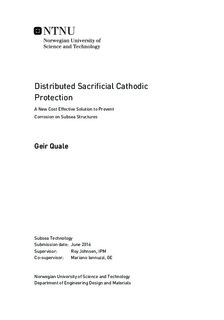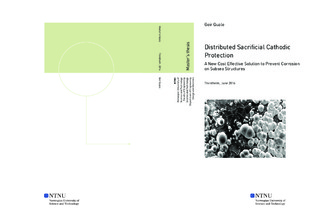| dc.description.abstract | Over the last 50 years, only minor changes have been made to the cathodic protection (CP) design, whereas optimization has not been considered as a cost saving opportunity to date. For subsea structures, sacrificial anodes combined with organic coatings are the main corrosion protection strategy. Depending on the lifetime of the subsea system, the complexity of the structure to be protected, and the environmental conditions, the total anode mass can be substantial. The anode mass does not only increase fabrication costs, but also affects the total structure weight in a way that puts special requirements on lifting vessels and cranes. Reducing this weight may not only be cost efficient, but also improve the safety during installation due to less complex lifting operations.
In this study, the electrochemical properties of a new concept named CP by distributed sacrificial anode (DSA) was investigated, with the main focus on the anodic capabilities in comparison to those of conventional sacrificial Al-Zn-In anodes and thermally sprayed aluminum (TSA-Al99.5). The main principle of CP by DSA is to convert the cathode area to anode area by distributing anode mass on the surface of the equipment to be protected. DSA was achieved by deposition of a dual layer metallic coating, consisting of a TSA layer applied on carbon steel (CS) plates, followed by sacrificial outer Al-Zn-In layer on top. This was done by arc-spraying, a thermal spray technique. Freely exposed specimens as well as galvanic couplings between DSA, TSA, conventional anode and CS with area ratio 1:1, 10:1 and 100:1 were immersed in nearly stagnant flowing seawater at 10 ± 2℃ and 40 ± 5℃. Continuously monitoring of the open circuit potential (OCP) and the current demand for the couplings were conducted as well as periodically obtaining potentiodynamic polarization curves in order to investigate the electrochemical properties with respect to exposure time. After 30 days exposure, surface and cross-section examination was conducted using scanning electron microscope (SEM) coupled to an energy-dispersive spectroscopy (EDS).
The results from this study indicate that DSA have similar anodic properties as for those of conventional sacrificial anodes, and can supply sufficient CP to a substantial larger defect compared to TSA coatings. When used as a CP system, protecting a 10% holiday i.e. exposed CS, the coupling potential was not affected and held the same potential as for freely exposed DSA, at −1000 mVAg/AgCl. The effective polarization properties provides initial high current output to the CS area, but decreases rapidly due to a dense calcareous deposition, contributes to an overall lower degradation rate of the coating in comparison to TSA under similar conditions. The cathodic properties for DSA is changed with respect to the bulk material, the sacrificial anode. The reason is either due to reduced content of Zinc and Indium as a result of the thermal spraying process and/or due to increased oxidation properties. This also affected the OCP, contributing to a nobler potential. The cathodic properties are similar to those of TSA at cathodic polarization between −1100 mVAg/AgCl and −1550 mVAg/AgCl, thus when connected to a conventional sacrificial anode, the current drain is similar as for TSA, between 6-10 mA/m2. | |

